Tesla Powerwall battery saves family $5,700 on electric bill
Huge savings after just four years

I’ve been toying with the idea of installing solar panels and a Tesla Powerwall in my house for a long time, but I haven’t because I wasn’t entirely convinced about the long term savings. This story of an Australian household saving $5,700 on electricity bills may have changed that.
According to Natural Solar — a Tesla Powerwall and solar panel installer in Australia — this is what happened to the Pfitzner family, which it claims are the first home in that continent to install the Powerwall four years ago. Looking back at their electricity invoices, the family claims that they have saved $5,700 so far in bills.
How does the Tesla Powerwall work?
The setup is very simple. You can install the Tesla Powerwall — or a similar device — at any home. It’s a set of smart batteries contained in an electronically monitored package. The package is connected to an energy generator like a solar panel. The Powerwall then provides with electricity to the entire house.
The system ensures a constant flow of energy to your entire home. At night, it will supply all the energy. During the day, it will kick in to supplement the solar panels output whenever they can’t keep up with the home’s demand.
You don’t even have to have a solar system in place. There are households that use these batteries to grab energy from the standard power grid when the prices are low (like deep at night or certain hours during the day) and store it for later use, so they can keep prices down. But obviously, if you have a way to generate energy yourself, the savings will be dramatically bigger. Enough to allow you cutting the cord from the power grid entirely.
Recouping costs in seven years
That many not seem like a lot, but it’s more than notable for two reasons:
First, the Pfitzner family must consume a lot of electricity. They have a four-bedroom home with full laundry equipment — which I assume means washer and dryer — and air conditioning. That’s a lot of clothes to clean and lot of cubic feet of air to cool down or heat up during the year. The family says that it also has “state of the art appliances, a pool, and outdoor entertaining area,” so the fact that it saved $5,700 over four years is notable.
Sign up to get the BEST of Tom's Guide direct to your inbox.
Get instant access to breaking news, the hottest reviews, great deals and helpful tips.
The best part, however, is how they are recouping costs based on these savings. The Pfitzner’s spent a total of $10,800 installing the Tesla Powerwall, the solar panels, and all the hardware needed for their home to run on solar energy. They calculate they will get all their investment back in just seven years, and after that, it will all be free energy.
Natural Solar claims that the return on investment usually happens after two decades. Which, ok, fine, I will help save the planet but I may be dead by then. Seven years, however, seems like a lot more attractive proposition.
Saving the world one household at a time
Cutting the cord has other advantages than saving and being able to break away from the ever-hungry ConEdisons of this world. Moving to solar energy will greatly help in reducing carbon emissions on a daily basis. Getting off the electric grid made the Pfitzner’s save an estimated 6 tonnes of carbon emissions per year. So it’s a perfect trifecta that will make your pocket, your mind and your heart feel good.
Knowing all this, I can’t understand why these types of batteries — from Tesla or anyone else — are not mandatory for all new homes everywhere. Not only can they greatly help reduce carbon emissions, but the industry will explode, bringing new jobs and money into the economy. That’s the kind of real-world Earth saving everyone can get behind.
Jesus Diaz founded the new Sploid for Gawker Media after seven years working at Gizmodo, where he helmed the lost-in-a-bar iPhone 4 story and wrote old angry man rants, among other things. He's a creative director, screenwriter, and producer at The Magic Sauce, and currently writes for Fast Company and Tom's Guide.

